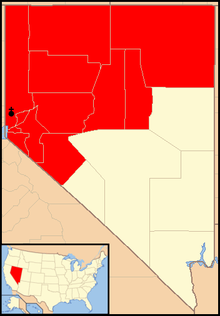Norman Francis McFarland
| Styles of Norman McFarland | |
|---|---|
.svg.png) | |
| Reference style | The Most Reverend |
| Spoken style | Your Excellency |
| Religious style | Monsignor |
Norman Francis McFarland (February 21, 1922 – April 16, 2010) was the second Roman Catholic Bishop of the Diocese of Orange. He had previously served as an auxiliary bishop of the Archdiocese of San Francisco, Apostolic Administrator of the Diocese of Reno and bishop of the renamed Diocese of Reno-Las Vegas.
Early life and pastoral appointments
Norman McFarland was born in Martinez, California as the third oldest son of Francis and Agnes (Kotchevar) McFarland. He went to public schools and eventually attended Saint Joseph Seminary in Mountain View, California. McFarland earned his Bachelor of Arts degree in 1943 at Saint Patrick Major Seminary.[1] He was ordained to the priesthood on June 15, 1946 by Archbishop John J. Mitty for the Archdiocese of San Francisco.[2]
In 1946, McFarland was an associate pastor at St. Andrew's in Oakland, California when he was selected by Archbishop Mitty to attend the Catholic University of America.[2] He earned a Doctor of Canon Law degree and returned to the archdiocese.[3] McFarland served in a number of archdiocesan positions, including as a marriage tribunal official and a professor at Lone Mountain College and San Francisco College for Women.[3]
Episcopal appointments
Archdiocese of San Francisco
McFarland was appointed as the archdiocese's Auxiliary Bishop on June 5, 1970.[3] He was consecrated on September 5 as the Titular Bishop of Bida by Archbishop Joseph McGucken. His principal co-consecrators were Bishops Hugh Donohoe and Merlin Guilfoyle McFarland was appointed as the Vicar for Finance, Vicar for Seminarians, and Pastor in residence at Old Mission Dolores.[2]
Diocese of Reno
On December 6, 1974 McFarland was appointed as the Apostolic Administrator of the Reno Diocese[3] by Pope Paul VI upon the resignation of Bishop Michael Joseph Green. As the administrator, he was in charge of finances for all of Nevada and is credited with covering "its debt by spending eight days on the phone asking bishops around the country for grants and low-interest loans."[1] McFarland became Reno's ordinary on February 10, 1976. As its diocesan bishop the name of the diocese was changed to Reno-Las Vegas. McFarland also expanded the funding for Catholic Charities.[1]
Diocese of Orange
McFarland was appointed as the Bishop of the Diocese of Orange on December 29, 1986 upon the death of Bishop William Johnson by Pope John Paul II.[4] Johnson was the first Bishop of Orange which is the second-largest diocese in California.[4] McFarland was consecrated as its bishop on February 24, 1987.
In 1995, after hearing McFarland's homily at the Red Mass for Orange County, several Orange County Bar Association member lawyers formed the St. Thomas More Society of Orange County.[5]
Prior to his 76th birthday in 1998, McFarland submitted his resignation which was accepted by Pope John Paul II.
Final years
In 2003, McFarland was inducted to the Mater Dei High School Ring of Honor.[6] McFarland was recognized during the annual spring Ring of Honor and Founders Circle Dinner for his contributions towards their community.[6]
McFarland suffered a heart attack and died on April 16, 2010.[7][8] His Mass of the Resurrection was held at the Holy Family Cathedral in Orange, California on April 23, 2010.[9]
Sources
- The Roman Catholic Diocese of Orange www.rcbo.org Retrieved: 2010-04-20.
- The Most Reverend Norman Francis McFarland, D.D., J.C.D. www.rcbo.org Retrieved: 2010-04-20.
References
- 1 2 3 "OC bishop McFarland dead at 88". Press-Telegram. April 16, 2010. Retrieved 2010-04-27.
- 1 2 3 "The Most Reverend Norman Francis McFarland, D.D., J.C.D." (PDF). Roman Catholic Diocese of Orange. June 29, 1998. Retrieved 2010-04-20.
- 1 2 3 4 "Pope Accepts Bishop Mcfarland's Resignation, Names Bishop Tod Brown to Orange; Bishop Mcgrath Appointed Coadjutor of San Jose; Msgr. Wester Is Named Auxiliary Bishop of San Francisco". USCCB. April 16, 2010. Retrieved 2010-04-20.
- 1 2 "POPE NAMES CALIFORNIA BISHOP". NY Times. January 1, 1987.
- ↑ "St. Thomas More Society of Orange County, CA". www.catholicbusinessjournal.biz. 1995. Retrieved 2010-04-21.
- 1 2 "Ring of Honor Advancement". Mater Dei High School. 2010. Retrieved 2010-04-20.
- ↑ "Former Orange County Bishop Dies At 88". CBS2. April 16, 2010. Archived from the original on April 18, 2010. Retrieved 2010-04-20.
- ↑ "PASSING OF THE MOST REVEREND NORMAN MCFARLAND, RETIRED BISHOP OF ORANGE". Roman Catholic Diocese of Orange. April 16, 2010. Archived from the original on May 21, 2010. Retrieved 2010-04-20.
- ↑ Mark Eades (April 24, 2010). "The funeral mass of Bishop McFarland". OCRegister.
Episcopal succession
McFarland's direct Apostolic succession is delineated from Cardinal Scipione Rebiba. 91% of the world's more than 4,000 Catholic bishops alive today trace their episcopal lineage back to Rebiba.
| Catholic Church titles | ||
|---|---|---|
| Preceded by Michael Joseph Green |
Bishop of Reno-Las Vegas 1976–1986 |
Succeeded by Daniel F. Walsh |
| Preceded by William Robert Johnson |
Bishop of Orange 1986–1998 |
Succeeded by Tod David Brown |
| Episcopal lineage | |
| Consecrated by: | Joseph McGucken |
| Consecrator of | |
|---|---|
| Bishop | Date of consecration |
| Michael Patrick Driscoll | March 6, 1990 |
.svg.png)
